What is the mainland European gauge, I think the advantage of 'straight through' would outweigh the advantage of a slightly wider UK only gauge.The main problem with today's UK gauge seems to be the tunnels, bridges and platforms which would be built from scratch for a new line anyway.IIRC, there was an attempt at a double decker on existing UK gauges, some said it was OK, others saying it was cramped.As the Times article says, there should be an oportunity for coastal container freight once there is a continuous stream of traffic, just treat coastl routes the same as canals are going to be treated.
You are using an out of date browser. It may not display this or other websites correctly.
You should upgrade or use an alternative browser.
You should upgrade or use an alternative browser.
Green and Pleasant Land
- Thread starter The Dean
- Start date
Would the SkyCat concept be possible in this time frame?http://www.worldskycat.com/markets/skyferry1.html
Here is a formate of my TL readable on the forum
G&PL
Brochure publicising 60th anniversary published in Commission journal
OTL
Increasing congestion causing regular delays in SE England. Rail infrastructure degenerating.
2008
G&PL
60th anniversary of Commission.
OTL
?????
I still prefer the format on this pdf but I have not found a way to put it on the forum in this style yet.
G&PL Timeline Table.pdf
This is exactly what I had in mind and it is being included and you will be able to see it in the final version of the 60th anniversary brochure and articals dedicated exclusivly to lighter than air transport.
GREEN AND PLEASANT LAND (or how it could have been)
An alternative timeline based on transport in the United Kingdom of Great Britain
1948
G&PL
Formation of British Transport Commission
OTL
Formation of British Transport Commission.
1949
G&PL
First test train of the 0-6-6-0-T Bullied Leader class locomotive.
OTL
Only test train of the 0-6-6-0-T Bullied Leader class locomotive.
1951
G&PL
BR Standard design locomotives introduced. Standardisation across rail system implemented.
OTL
BR Standard design locomotives introduced. Standardisation across rail system attempted.
1953
G&PL
Executive barriers to the integration of the transport systems removed completely. London Transport coming in the Commission's brief.
OTL
Executive barriers to the integration of the transport systems removed apart from the London Transport Executive.
1955
G&PL
Road Haulage assets standardised in system. Fifteen year rail modernisation begun. Multifuel (granulated coal, fuel oil and gas) fired boilers developed driving turbine motors. New rolling stock developed. Permanent way and signalling upgraded.
OTL
Road haulage assets denationalised. Fifteen year rail modernisation begun. Electrification of principle main lines. Introduction of Diesel locomotives. New rolling stock developed. Permanent way and renovated signalling upgraded
1956
G&PL
Fear of Middle East oil embargo after Suez stimulates extensive renovation of waterways and existing oil pipelines are extended.
OTL
Commission takes no action after Suez.
1958
G&PL
Less efficient design locomotives replaced by new build post war designs. Second generation locomotives begin to come into service. Passenger trains using articulated carriages and driving cab on the rear tested and start to enter service. More inland waterways are opened up and coastal shipping increased.
OTL
Mass withdrawal of pre-grouping locomotives begun. Electrification of the West Coast main line begun using the French A/C overhead system despite having already spent large sums on their own D/C system ten years ago. Preston bypass opens as Britain's first dedicated motorway.
1960
G&PL
Newly renovated and widened canals increase their goods traffic.
OTL
First 72 miles of M1 motorway open.
1959
G&PL
Standardisation of all permanent ways begun.
OTL
Closure of permanent ways begun.
1962
G&PL
Commission starts to negotiate for the inclusion
of aerial transport in its brief.
OTL
Commission is abolished.
1969
G&PL
First flight of Concorde
OTL
First flight of Concorde
1994
G&PL
Channel tunnel opened.
OTL
Channel tunnel opened
2007
2007
G&PL
Brochure publicising 60th anniversary published in Commission journal
OTL
Increasing congestion causing regular delays in SE England. Rail infrastructure degenerating.
2008
G&PL
60th anniversary of Commission.
OTL
?????
I still prefer the format on this pdf but I have not found a way to put it on the forum in this style yet.
G&PL Timeline Table.pdf
Would the SkyCat concept be possible in this time frame?http://www.worldskycat.com/markets/skyferry1.html
This is exactly what I had in mind and it is being included and you will be able to see it in the final version of the 60th anniversary brochure and articals dedicated exclusivly to lighter than air transport.
Attachments
Last edited:
Hendryk
Banned
It's okay, your presentation is pretty user-friendly. And I must say it's useful to have events in OTL as a frame of reference; I for one did know the dates for Concorde and the opening of the Channel Tunnel but not the earlier stuff.I still prefer this format on this pdf but I have not found a way to put it on the forum in this style yet.
Navigable waterways 2007
This is a map of the inland waterway system as it exists today the broken lines are canals under restoration. This does not show the full extent of the system at its peak nor does it show the networks in urban areas. If work on the system had been started back in the 1950s this map would be far more extensive.
If this is looked at in conjunction with all of the ports on the coast then you can see how my proposals for the majority of bulk transport being by water would be feasible. Many of the older electricity generating stations are on rivers or next to seaports. This after all is one methods Margaret Thatcher used to break the Miners Strike importing foreign coal to the generating stations and it never even coming ashore.

This is a map of the inland waterway system as it exists today the broken lines are canals under restoration. This does not show the full extent of the system at its peak nor does it show the networks in urban areas. If work on the system had been started back in the 1950s this map would be far more extensive.
If this is looked at in conjunction with all of the ports on the coast then you can see how my proposals for the majority of bulk transport being by water would be feasible. Many of the older electricity generating stations are on rivers or next to seaports. This after all is one methods Margaret Thatcher used to break the Miners Strike importing foreign coal to the generating stations and it never even coming ashore.

Restoration of the inland waterways post Suez
My next entry in Green and Pleasant Land takes the form of an article in the spring journal of the British Transport Commission in 1956. The work I have described happened very much later in OTL. The shame of it is that it was carried out in the main part for or by the leisure industry.
It is only in recent years that transport planners have acknowledged that waterborne transport is more energy efficient. Now in their desperation to relieve the increasing congestion on the overloaded road system they are increasingly turning to the waterways as well as the railways to take traffic away from roads. Traffic that need not have been there in the first place.
The use of service personnel to carry out work of this nature is not unknown and I have been involved in schemes where this has taken place under the umbrella of training.
My next entry in Green and Pleasant Land takes the form of an article in the spring journal of the British Transport Commission in 1956. The work I have described happened very much later in OTL. The shame of it is that it was carried out in the main part for or by the leisure industry.
It is only in recent years that transport planners have acknowledged that waterborne transport is more energy efficient. Now in their desperation to relieve the increasing congestion on the overloaded road system they are increasingly turning to the waterways as well as the railways to take traffic away from roads. Traffic that need not have been there in the first place.
The use of service personnel to carry out work of this nature is not unknown and I have been involved in schemes where this has taken place under the umbrella of training.
Article from the spring journal of the British Transport Commission 1956
derelict locks
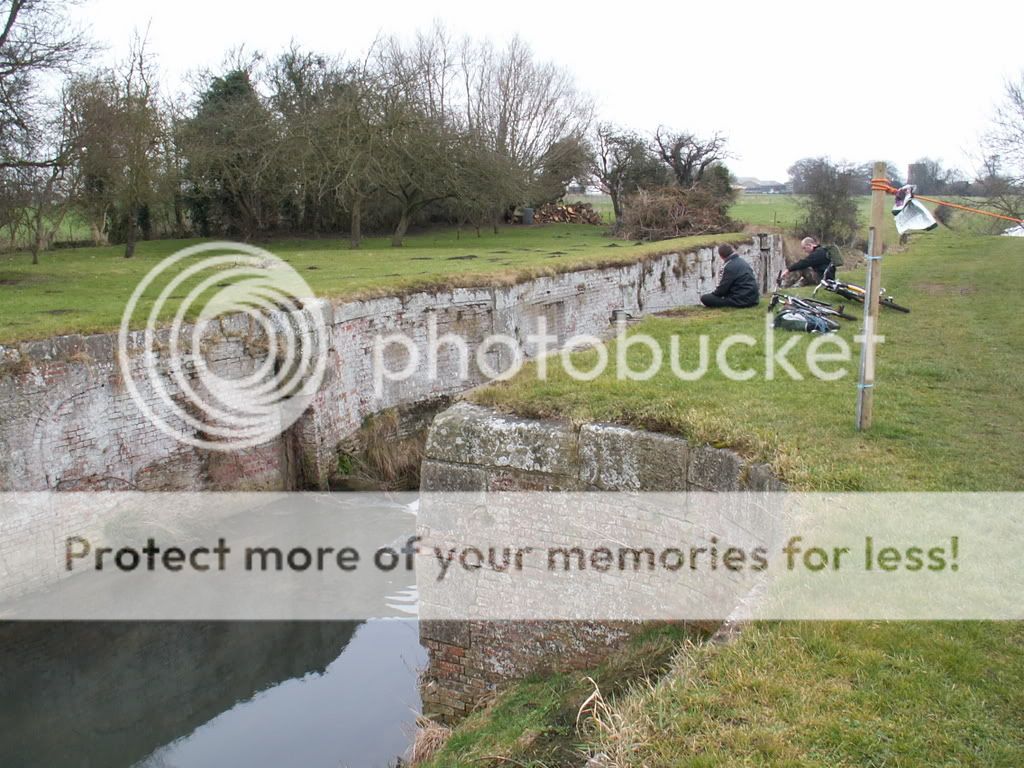
and unsafe tunnels
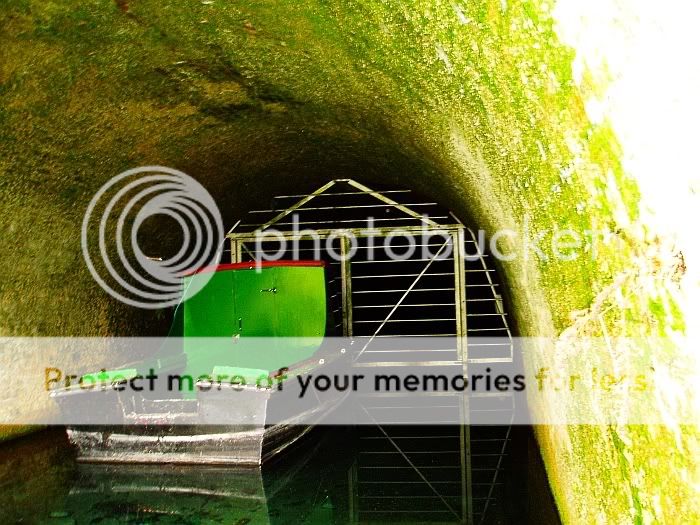
Greywell tunnel
However with a system covering a large part of the country taking in most of the major industrial sites the work was begun to bring the whole system into operation. There was a large amount of surplus equipment from the military available which could be used for the work and in some places tasks were carried out by service personnel as training exercises.
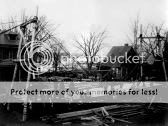
First of all overgrown and weed infested cuts had to be cleared and in some cases relined. A mixture of old methods and new techniques were used to implement this work. Once a stretch of water was cleared between locks the locks themselves would be dealt with. Then tunnels, viaducts and overbridges would be dealt with as they were reached. In this manner the work would proceed along the cut until the whole route was navigable.
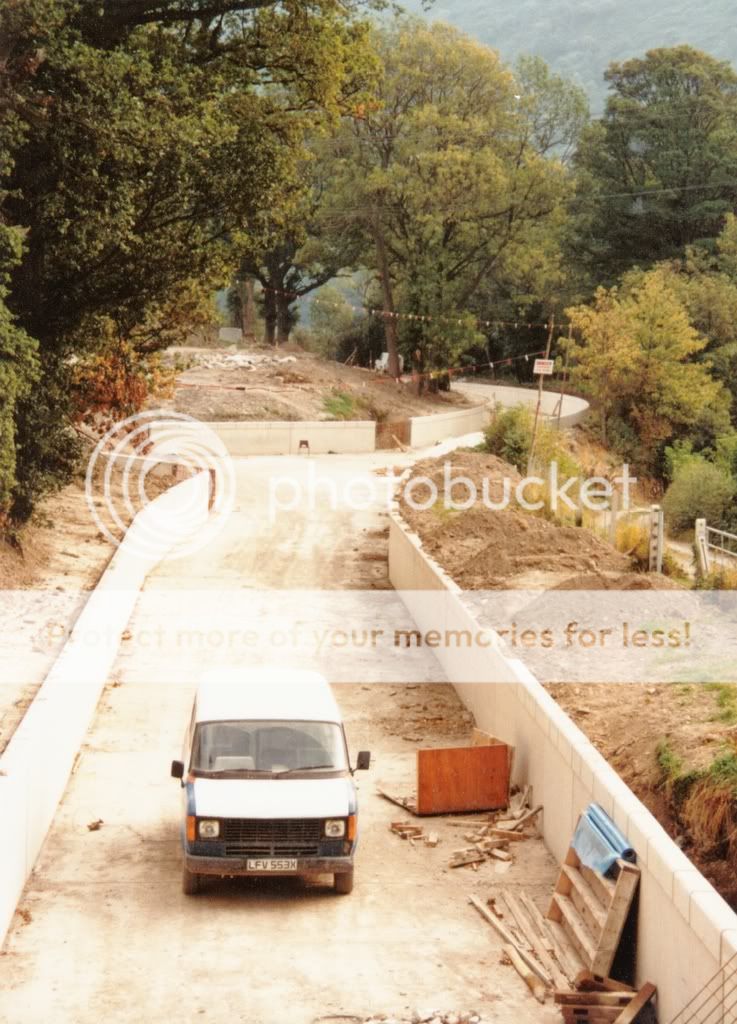
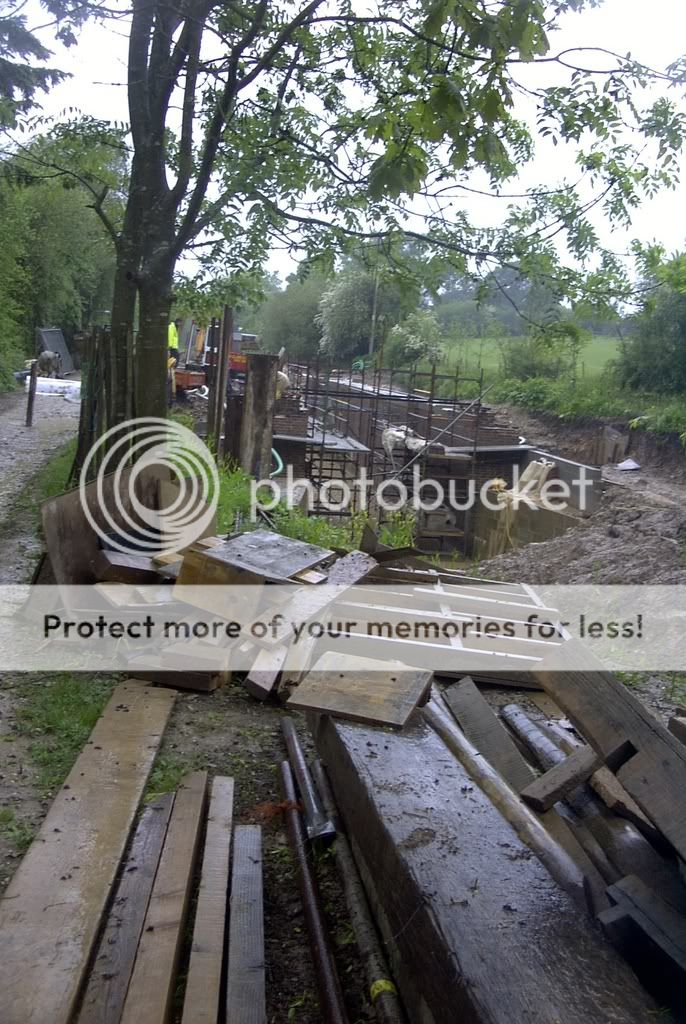
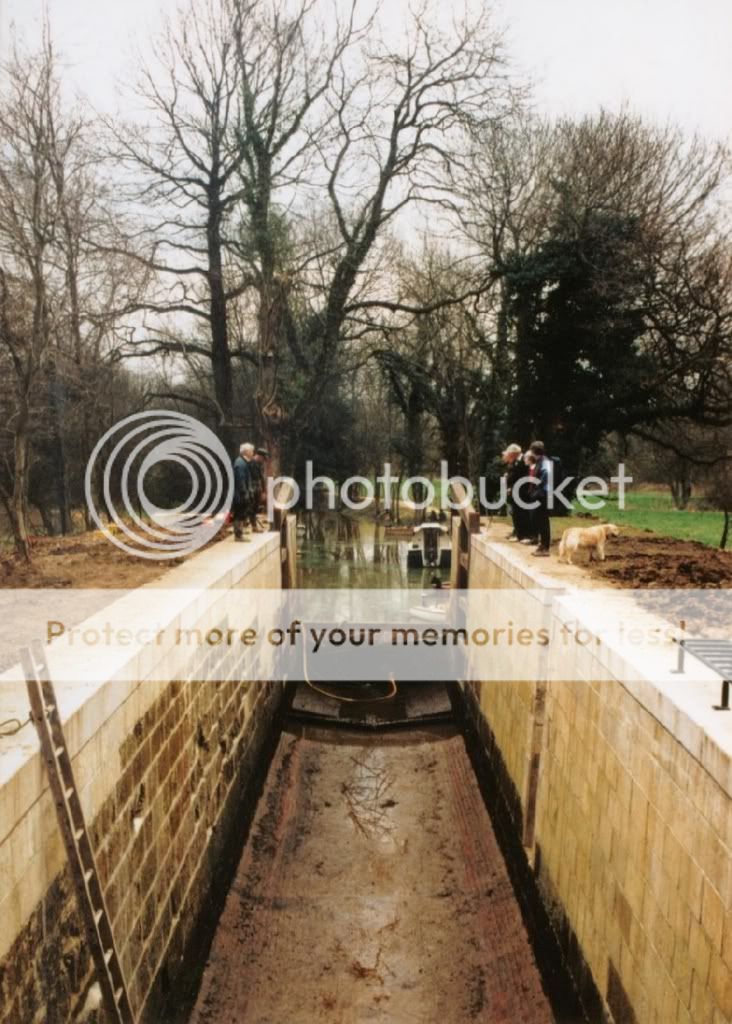
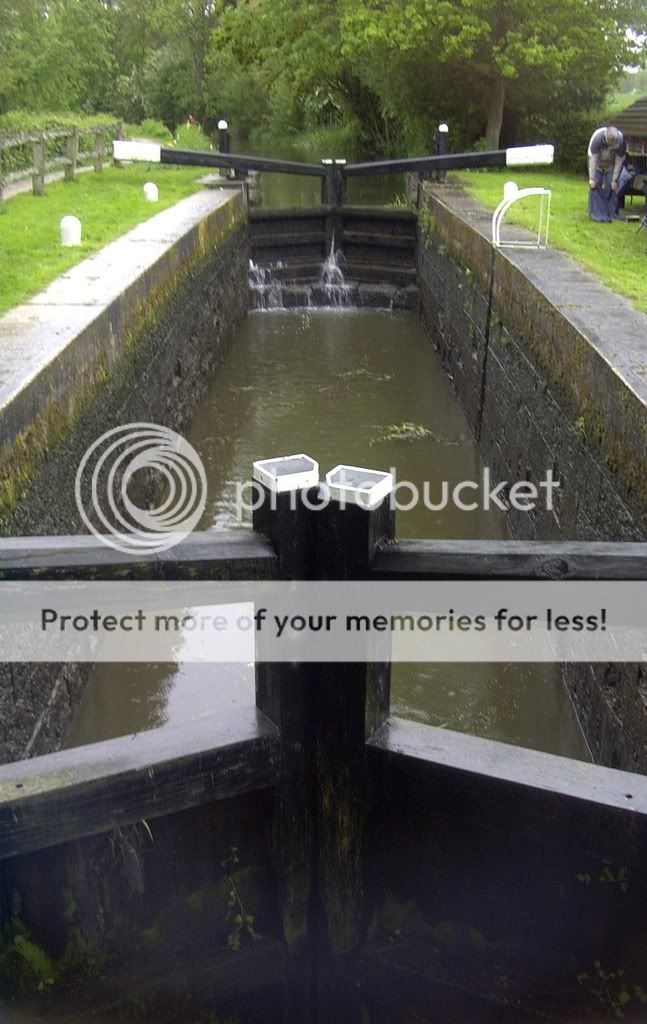
POST SUEZ REFURBISHMENT
OF THE INLAND WATERWAYS
After the decision had been made to make maximum use of water transport after President Nasser's initiation of an oil embargo on Britain, France and Israel after Suez a rapid survey was made of the canal system. This revealed much delapidation and neglect and an extensive program of renovation had to be started. This ranged from overgrown and dried up watercourses,
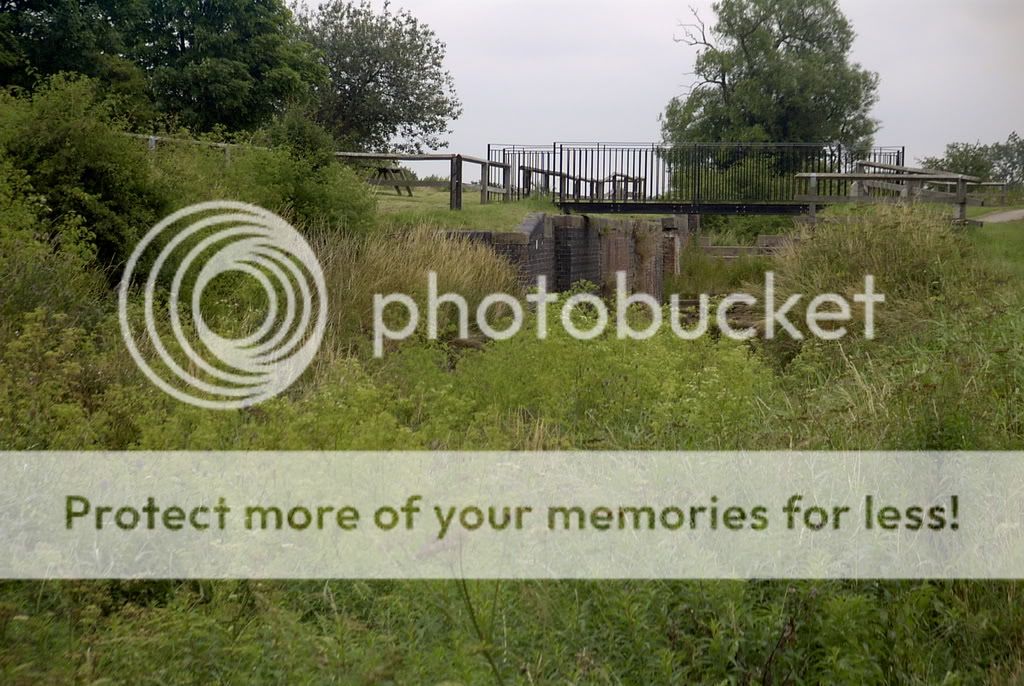

Grantham canal
derelict locks

Alvingham lock
and unsafe tunnels

Greywell tunnel
However with a system covering a large part of the country taking in most of the major industrial sites the work was begun to bring the whole system into operation. There was a large amount of surplus equipment from the military available which could be used for the work and in some places tasks were carried out by service personnel as training exercises.

Royal Engineer soldiers repairing isolated bridge
First of all overgrown and weed infested cuts had to be cleared and in some cases relined. A mixture of old methods and new techniques were used to implement this work. Once a stretch of water was cleared between locks the locks themselves would be dealt with. Then tunnels, viaducts and overbridges would be dealt with as they were reached. In this manner the work would proceed along the cut until the whole route was navigable.


Work on the watercourses of the Llangollen and Wey and Arun canals


Before and after restoration of a lock on the Wey and Arun canal
In this manner the system went from the level shown in this map
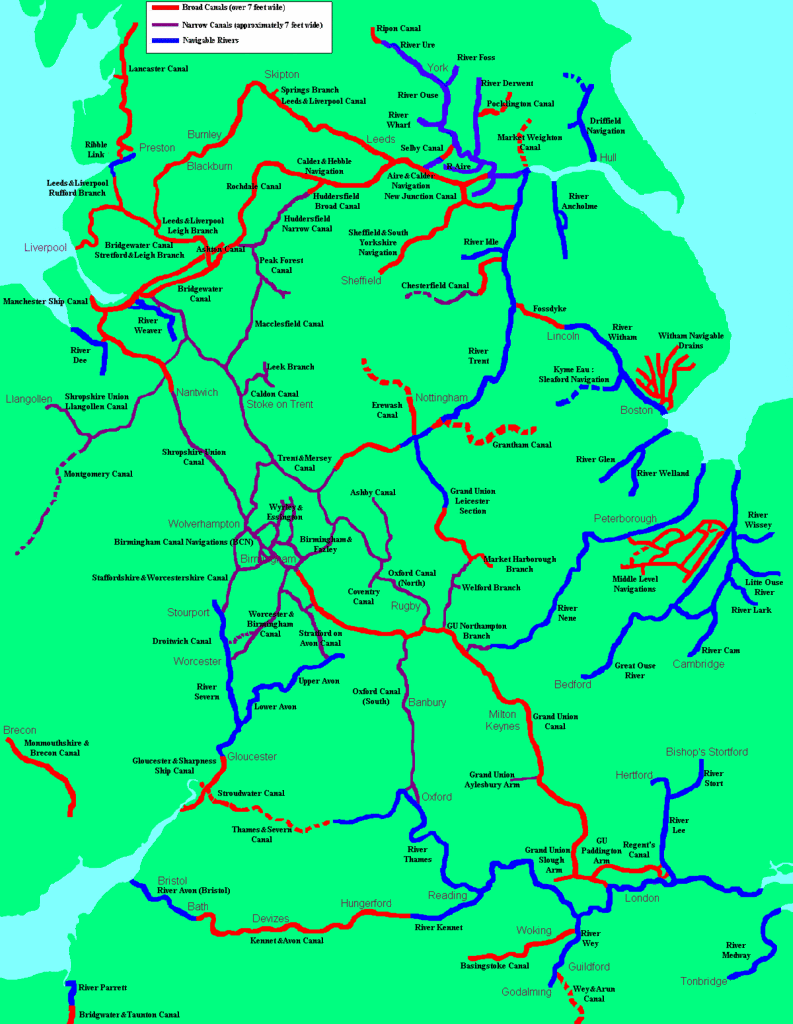

to the current level today. Of course the old tow paths along the routes of the canals make fine footpaths and cycleways for shorter journeys. In the future plans are being made to connect the Lancaster canal around Preston via the river Ribble to join the Leeds and Liverpool canal and to reopen the Wilts and Berks canal.
Last edited:
Redbeard
Banned
What a pleasure to see such an innovative PoD and such a well documented ATL 
I guess the main "problem" would be back when the alternative to waterways and trains were trucks going from door to door on empty roads. Seen from then the truck on road was a revolution in logistics, and only now do we realise that the good times are over.
Here in Denmark trucks so heavy and long that they can't use ordinary roads, but only go between transfer stations at the freeways, have just been allowed.
Compared to double the number of smaller trucks it will probably feel good on the freeways, but I just have to ask where is the original advantage over trains and coastal freighters?
As I also understand the ATL says, the key probably lies in the price and accessability of oil. In OTL oil beacme a both cheap and reliable source of energy after WWII, but if we have an early and serious oilcrisis in the immediate postwar years there would be an institutional interest in a coal producing nation like GB to keep the trains in business. I wonder if this could also produce an extensive and working early containerisation with railways and waterways as the base? If so the initial time advantage of the "truck on empty road" system probably could be significantly reduced if not deleted alltogether.
Regards
Steffen Redbeard
I guess the main "problem" would be back when the alternative to waterways and trains were trucks going from door to door on empty roads. Seen from then the truck on road was a revolution in logistics, and only now do we realise that the good times are over.
Here in Denmark trucks so heavy and long that they can't use ordinary roads, but only go between transfer stations at the freeways, have just been allowed.
Compared to double the number of smaller trucks it will probably feel good on the freeways, but I just have to ask where is the original advantage over trains and coastal freighters?
As I also understand the ATL says, the key probably lies in the price and accessability of oil. In OTL oil beacme a both cheap and reliable source of energy after WWII, but if we have an early and serious oilcrisis in the immediate postwar years there would be an institutional interest in a coal producing nation like GB to keep the trains in business. I wonder if this could also produce an extensive and working early containerisation with railways and waterways as the base? If so the initial time advantage of the "truck on empty road" system probably could be significantly reduced if not deleted alltogether.
Regards
Steffen Redbeard
What about airships? They wouls be able to reach places quickly with no obstacles in the way and could carry a lot.
Yes I was envisaging the BTC investigating the possibilities of airships when they get responsibility for air transport added to their brief in 1962. Something like this for freight

Which would be far more fuel efficient than helicopters and heavy transport airoplanes. Then this for passenger transit.

Hendryk
Banned
That would be very interesting. As you've noticed, "airship" at AH.com is shorthand for "ATL that sacrifices plausibility to the aesthetical whims of its author", and one may rightly consider that more than a little unfair considering the potential of lighter-than-air transport as a cost-effective, environmentally-friendly way of moving freight and people around. So if you manage to include airships in this impeccably realistic TL of yours, methinks you'll do the AH community quite a favorYes I was envisaging the BTC investigating the possibilities of airships when they get responsibility for air transport added to their brief in 1962.
It is interesting that now as crisis point has been reached in carbon emissions and congestion decision makers now looking at the possibilities of inland waterways and lighter than air machines for transport. Even the Zeppelin company are back in the business of building airships.
It was my desire to seek a way out of this that made me look how far back you would need to go to create a POD that would lead to a different path of development. Obviously I chose the insular setting of the British Isles as it was the area in which I had the most knowledge. Having said that I have driven trucks across Europe in a civilian capacity and a lot of the world in the Army.
I do not propose any Luddite tendencies to creep in and road vehicles including privately owned cars should and will have a place in the G&PL of my creation.
It is my longtime hobbyhorse, some 30 years now, that short term profit has taken precedent over long term needs to preserve precious non renewable resources and our environment. Unfortunately it is now a case of better late than never.
It was my desire to seek a way out of this that made me look how far back you would need to go to create a POD that would lead to a different path of development. Obviously I chose the insular setting of the British Isles as it was the area in which I had the most knowledge. Having said that I have driven trucks across Europe in a civilian capacity and a lot of the world in the Army.
I do not propose any Luddite tendencies to creep in and road vehicles including privately owned cars should and will have a place in the G&PL of my creation.
It is my longtime hobbyhorse, some 30 years now, that short term profit has taken precedent over long term needs to preserve precious non renewable resources and our environment. Unfortunately it is now a case of better late than never.
Thande
Donor
You've got to have airships 
Although doing it in this way is quite unusual. Usually, airships are either (1) in steampunk TLs based on further development of the zeppelin types seen in the 1910s and 1920s of OTL, or (2) a future development where they're brought back due to environmental considerations etc. Not unlike trams are now, in fact, so it makes sense for airships to go in tandem with them. This is indeed a very original TL.
Although doing it in this way is quite unusual. Usually, airships are either (1) in steampunk TLs based on further development of the zeppelin types seen in the 1910s and 1920s of OTL, or (2) a future development where they're brought back due to environmental considerations etc. Not unlike trams are now, in fact, so it makes sense for airships to go in tandem with them. This is indeed a very original TL.
will this TL involve less postwar suburbs/new towns?
if so, thats interesting as more people will stay in inner cities which might not decay- Britain might go comparitivly high rise and there might be better race relations (Non whites still move to Britain right?) with more people mixing together.
if so, thats interesting as more people will stay in inner cities which might not decay- Britain might go comparitivly high rise and there might be better race relations (Non whites still move to Britain right?) with more people mixing together.
Motorail and private cars.
This is my next entry in G&PL it concerns the provisions made for the private motorist by the BTC, I do not envisage massive spending on building an American or mainland European style expressway, autobahn/route or motorway system. The logic and convenience of putting a car on a faster and safer mode of transport are obvious.
This entry takes the form of an article in the spring 1972 Journal of the BTC previewing the services offered for the year ahead. Then I am posting the updated TL and some comments for you to look at after you have looked at the entry.
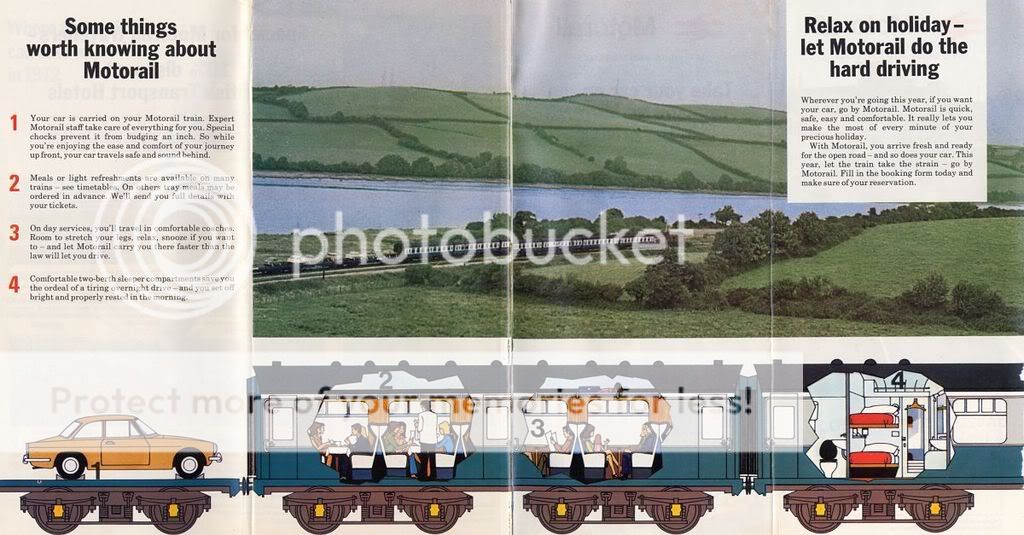
This includes dining cars night sleeper trains and discounted bookings in British Transport Hotels.
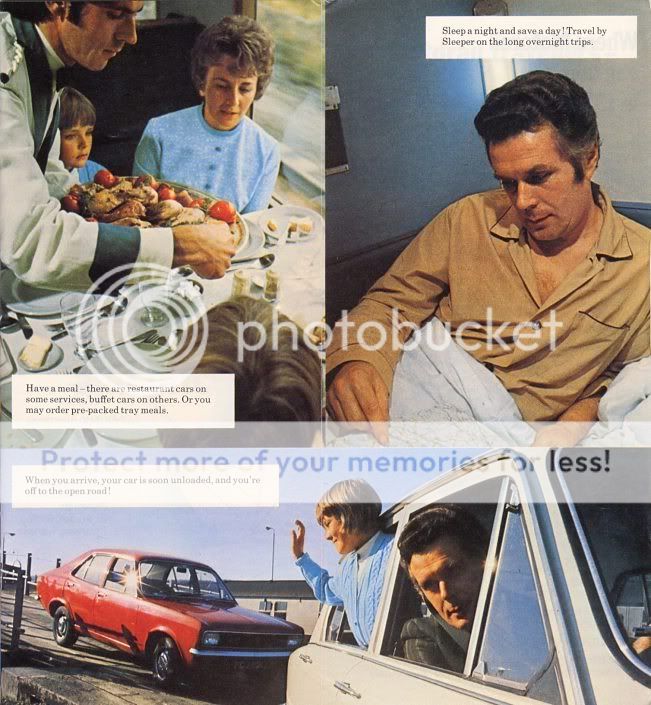
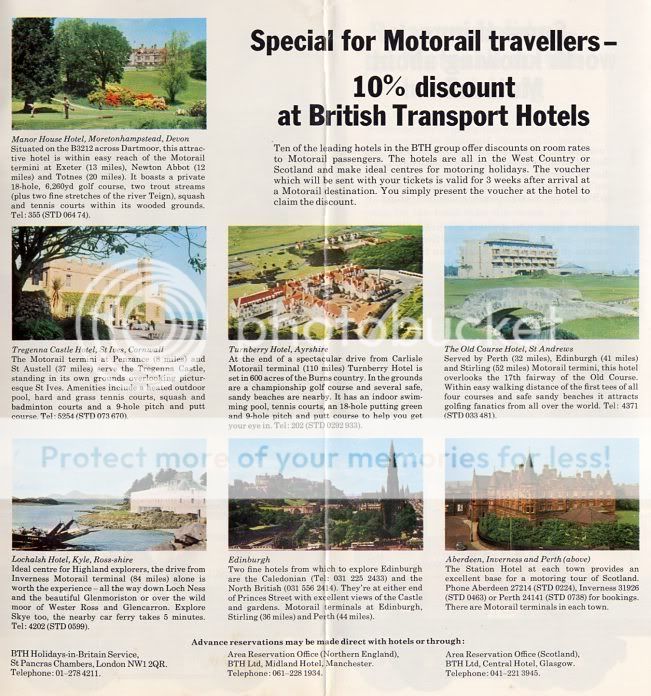

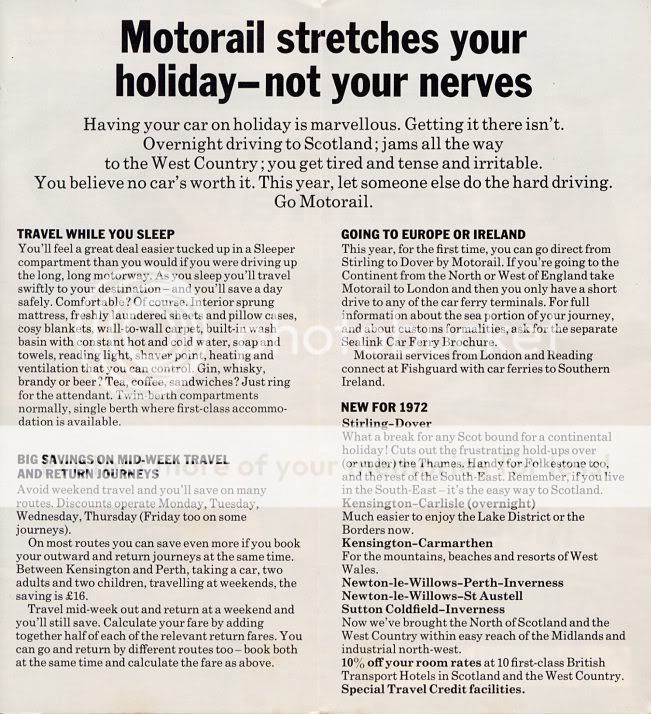
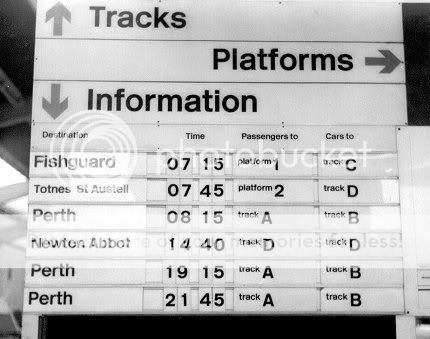
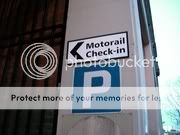
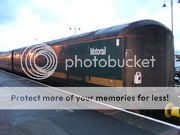
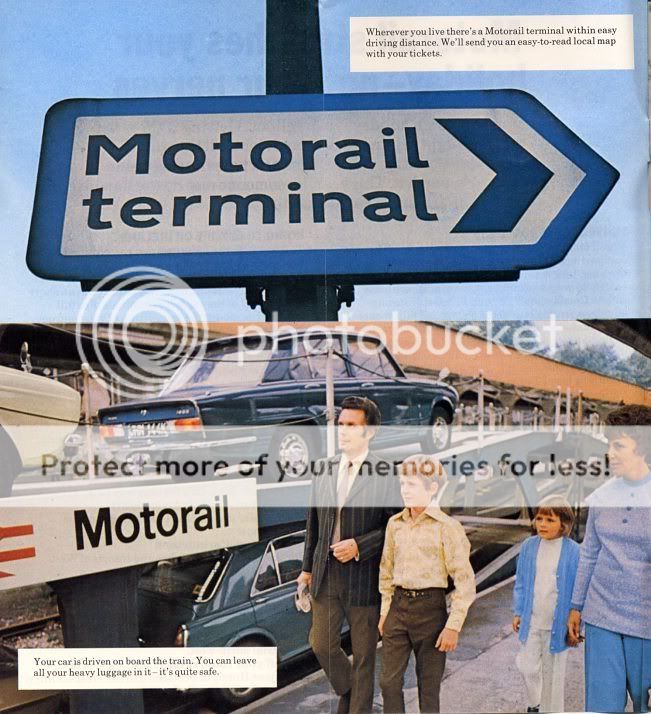
This was a service that I used regularly. I went climbing in Scotland and my sister has lived near Penzance for nearly 30 years. The journeys were both quicker and cheaper by motorail. Even on todays roads in the dead of night you could not drive these journeys in the time the train did them.
Work out the arithmetic, for instance London-Perth 500 miles plus at say 30mpg is nearly 20 gallons of petrol at roughly £1.00 a gallon in 1972. Then look at the fares.
With the added bonus of not arriving shattered by the journey. We could put our car on the train go to the bar in the station have a good session wake up with a cup of tea on the train in Perth breakfast in the cafe over the road and be be on the mountains by lunchtime rested and fed.
I have said previously that I do not have anti car tenancies I do personally enjoy driving. Unfortunately the way things are on our roads now there is very little pleasure in driving it is an extremely high stress activity. I should know I have been teaching people to drive for the last ten years. Any person who genuinely enjoys driving will tell you that pounding along a motorway is neither enjoyable or skillful.
birdy's and DoctorMo's comments on social effects are butterflies I had not fully considered and these are going to require some very careful thought to integrate in a plausible manner.
Airships WILL happen! They are irresistible and my task is going to make it plausible without things getting silly. I shall have to shake my head and get visions of airships like slowly drifting clouds floating over puffing steam trains out of my mind.
My new generation locomotives will look more like todays engines than traditional steam trains.
Latest TL as usual I have attached the TL in my preferred format for you to see.G&PL Timeline Table.pdf
This is my next entry in G&PL it concerns the provisions made for the private motorist by the BTC, I do not envisage massive spending on building an American or mainland European style expressway, autobahn/route or motorway system. The logic and convenience of putting a car on a faster and safer mode of transport are obvious.
This entry takes the form of an article in the spring 1972 Journal of the BTC previewing the services offered for the year ahead. Then I am posting the updated TL and some comments for you to look at after you have looked at the entry.
MOTORAIL OPERATIONS FOR 1972
As the private ownership of motorcars is increasing the desire to take their vehicle to use when travelling is increasing and the BTC is planning a large expansion of the Motorail service. Already there is a network of routes available for the passenger who prefers to use his own vehicle rather than hire one at the destination.
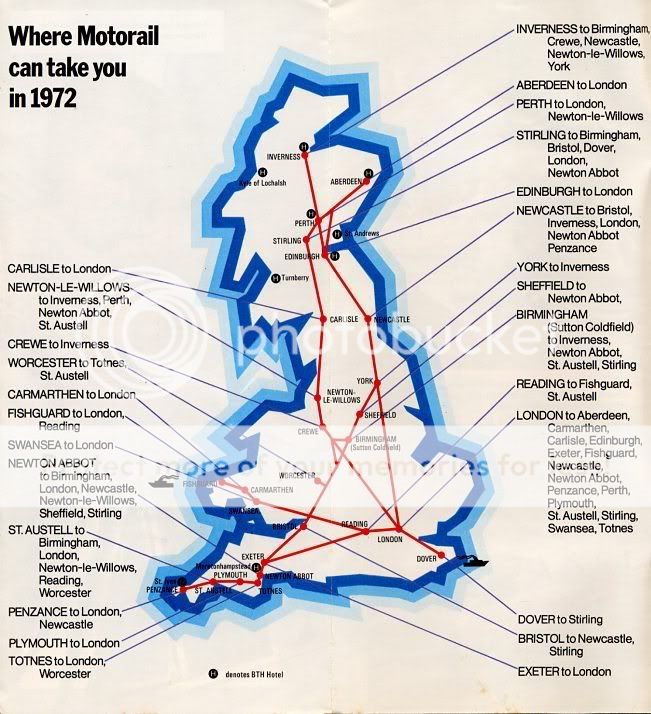

The Brochure below shows the services that Motorail offers its customers.
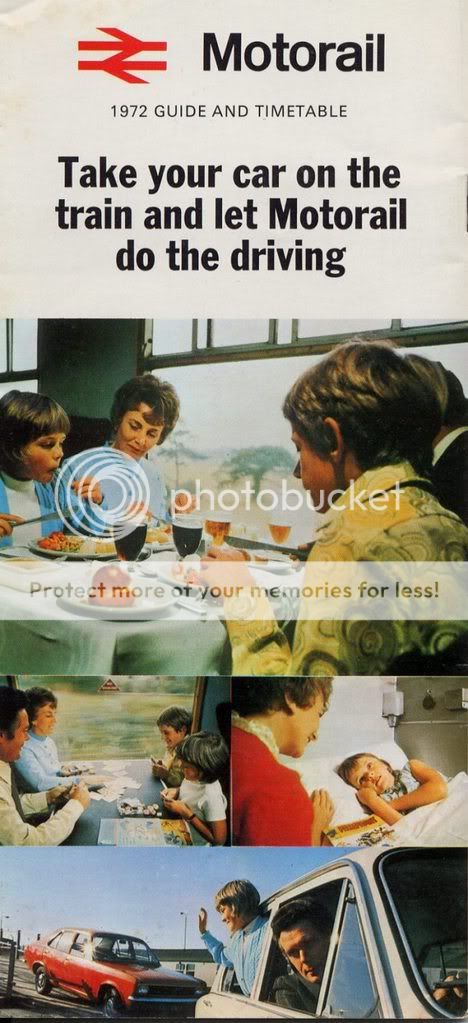
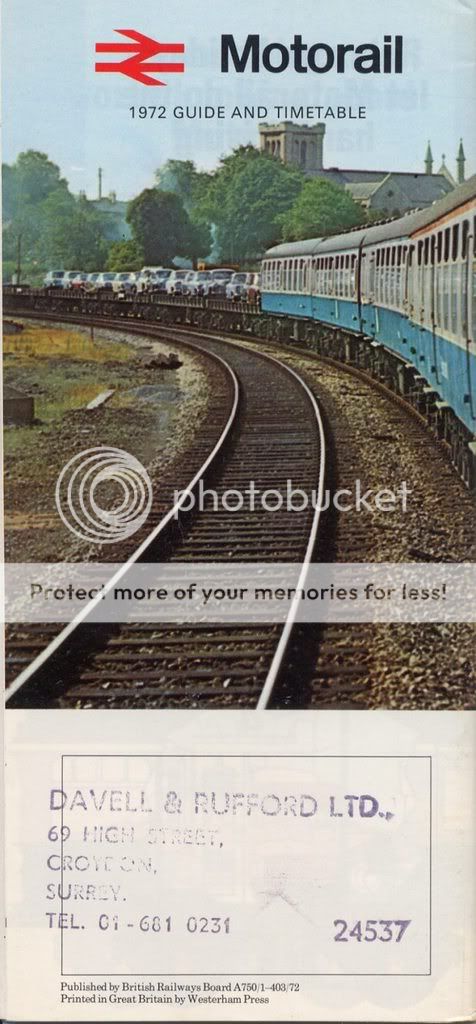



This includes dining cars night sleeper trains and discounted bookings in British Transport Hotels.



Here is a sample of the fares between London-Perth
Service ran nightly between early May and mid October, and three times a week between late March and 22nd October. Charges (Including sleeper berths) were £18.50 for a car and driver, with each additional adult £7.50 and each child £5.00. Return fares were around two thirds more than the single fare. Service ran 6 days a week between the end of May and 22nd September. Charges were £14.50 for a car and driver, with each additional adult £5.00 and each child £5.00. Return fares were in proportion rather cheaper than the overnight service.




This was a service that I used regularly. I went climbing in Scotland and my sister has lived near Penzance for nearly 30 years. The journeys were both quicker and cheaper by motorail. Even on todays roads in the dead of night you could not drive these journeys in the time the train did them.
Work out the arithmetic, for instance London-Perth 500 miles plus at say 30mpg is nearly 20 gallons of petrol at roughly £1.00 a gallon in 1972. Then look at the fares.
With the added bonus of not arriving shattered by the journey. We could put our car on the train go to the bar in the station have a good session wake up with a cup of tea on the train in Perth breakfast in the cafe over the road and be be on the mountains by lunchtime rested and fed.
I have said previously that I do not have anti car tenancies I do personally enjoy driving. Unfortunately the way things are on our roads now there is very little pleasure in driving it is an extremely high stress activity. I should know I have been teaching people to drive for the last ten years. Any person who genuinely enjoys driving will tell you that pounding along a motorway is neither enjoyable or skillful.
birdy's and DoctorMo's comments on social effects are butterflies I had not fully considered and these are going to require some very careful thought to integrate in a plausible manner.
Airships WILL happen! They are irresistible and my task is going to make it plausible without things getting silly. I shall have to shake my head and get visions of airships like slowly drifting clouds floating over puffing steam trains out of my mind.
My new generation locomotives will look more like todays engines than traditional steam trains.
Latest TL as usual I have attached the TL in my preferred format for you to see.G&PL Timeline Table.pdf
GREEN AND PLEASANT LAND (or how it could have been)
An alternative timeline based on transport in the United Kingdom of Great Britain
1948
G&PL
Formation of British Transport Commission
OTL
Formation of British Transport Commission.
1949
G&PL
First test train of the 0-6-6-0-T Bullied Leader class locomotive.
OTL
Only test train of the 0-6-6-0-T Bullied Leader class locomotive.
1951
G&PL
BR Standard design locomotives introduced. Standardisation across rail system implemented.
OTL
BR Standard design locomotives introduced. Standardisation across rail system attempted.
1953
G&PL
Executive barriers to the integration of the transport systems removed completely.
London Transport coming in the Commission's brief.
OTL
Executive barriers to the integration of the transport systems removed apart from the London Transport Executive.
1955
G&PL
Road Haulage assets standardised in system.
Fifteen year rail modernisation begun.
Multifuel (granulated coal, fuel oil and gas) fired boilers developed driving turbine motors.
New rolling stock developed.
Permanent way and signalling upgraded.
London-Perth Car/Sleeper introduced
OTL
Road haulage assets denationalised.
Fifteen year rail modernisation begun.
Electrification of principle main lines.
Introduction of Diesel locomotives.
New rolling stock developed.
Permanent way and renovated signalling upgraded
London-Perth Car/Sleeper introduced
1956
G&PL
Fear of Middle East oil embargo after Suez stimulates extensive renovation of waterways and existing oil pipelines are extended.
OTL
Commission takes no action after Suez.
1958
G&PL
Less efficient design locomotives replaced by new build post war designs.
Second generation locomotives begin to come into service.
Passenger trains using articulated carriages and driving cab on the rear tested and start to enter service.
More inland waterways are opened up and coastal shipping increased.
OTL
Mass withdrawal of pre-grouping locomotives begun.
Electrification of the West Coast main line begun using the French A/C overhead system despite having already spent large sums on their own D/C system ten years ago.
Preston bypass opens as Britain's first dedicated motorway.
1959
G&PL
Standardisation of all permanent ways begun.
OTL
Closure of permanent ways begun.
1960
G&PL
Newly renovated and widened canals increase their goods traffic.
OTL
First 72 miles of M1 motorway open.
1962
G&PL
Commission starts to negotiate for the inclusion
of aerial transport in its brief.
OTL
Commission is abolished.
1966
G&PL
Motorail brand introduced and London Olympia Terminal opened
OTL
Motorail brand introduced and London Olympia Terminal opened
1969
G&PL
First flight of Concorde
OTL
First flight of Concorde
1994
G&PL
Channel tunnel opened.
OTL
Channel tunnel opened.
1997
G&PL
Motorail transfer stations set up in every major City and town.
OTL
Motorail discontinued apart from London-Penzance
2005
G&PL
50th anniversary celebration of first Motorail route from London-Perth
OTL
London-Penzance Motorail discontinued
2007
G&PL
Brochure publicising 60th anniversary published in Commission journal
OTL
Increasing congestion causing regular delays in SE England. Rail infrastructure degenerating.
2008
G&PL
60th anniversary of Commission.
OTL
?????
Attachments
An excelant (if utopian!) timeline...
In OTL, the 1962 winter was extremely harsh winter and caused many of the main canals freeze over for months on end. This lead directly to the "death of the carrying trade [on the canals]", as road transport took up and then kept the business. I have seen the argument (I cant immediately recall where) that says this wasn’t just due to the advantages of road transport, but due to boatmen being laid off and having to find other work during the exceptionally long winter period and then not returning to the canals.
ITTL, obviously nothing can be done about the long winter stoppage caused by the freeze, but perhaps the already increased commitment to canal freight and the de-emphasis of road freight would allow some mitigation of the effect on the boater: subsistence payments or organised temporary employment in other branches of the BTC along with a guarantee that transport contracts should revert to the canals after the end of the “current abnormal weather conditions”? And after the freeze, I suspect it would be in the spirit of the timeline to encourage the return of traffic to the Cut… higher road taxes allowing for subsidies of canal transport, perhaps.
1960
G&PL
Newly renovated and widened canals increase their goods traffic.
OTL
First 72 miles of M1 motorway open.
1962G&PL
Commission starts to negotiate for the inclusion
of aerial transport in its brief.
OTL
Commission is abolished.
In OTL, the 1962 winter was extremely harsh winter and caused many of the main canals freeze over for months on end. This lead directly to the "death of the carrying trade [on the canals]", as road transport took up and then kept the business. I have seen the argument (I cant immediately recall where) that says this wasn’t just due to the advantages of road transport, but due to boatmen being laid off and having to find other work during the exceptionally long winter period and then not returning to the canals.
ITTL, obviously nothing can be done about the long winter stoppage caused by the freeze, but perhaps the already increased commitment to canal freight and the de-emphasis of road freight would allow some mitigation of the effect on the boater: subsistence payments or organised temporary employment in other branches of the BTC along with a guarantee that transport contracts should revert to the canals after the end of the “current abnormal weather conditions”? And after the freeze, I suspect it would be in the spirit of the timeline to encourage the return of traffic to the Cut… higher road taxes allowing for subsidies of canal transport, perhaps.
Share: